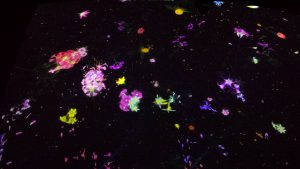What is Not Visible is Not Invisible is an exhibition held at the basement level of National Museum of Singapore(NMS). It features contemporary artworks from the French Regional Collections of Contemporary Art (FRAC) and all of the works explores the idea of intangibility as it encourages viewers to interact with it. The title reminded me of a short article I read on Refik Anadol’s 350 Mission Building titled Refik Anadol Turns The Invisible into The Visible as he used invisible data to create the installation that reflects the surrounding environment.
Like what the title describe – What is Not Visible is Not Invisible, similarly what is not observed is not unobserved. Perception of seeing happens within split seconds for one to be able to notice what has just been observed. Thus to bring out the unobservant of one, I was planning to use data based on the interaction people had with the environment (as colours are all around us) within NTU to bring awareness towards colour and its influence to the space around it with the use of processing. However I could not find any of such data on NTU website..
Some images taken from this exhibition that’s somewhat related to my topic.
I also went to Story of the Forest at NMS. A digital art installation that uses projectors to reflect the animation based on William Farquhar Collection of Natural History Drawings.














Great !
Please try to focus on existing data from the available site https://data.gov.sg/
The ” the interaction people had with the environment (as colours are all around us) within NTU” is a bit vague..maybe the flow of students – and or if data exist on number fo foreign students in Singapore?..or something related to environment..let meknow if this makes sense
It kind of make sense but I was thinking of how to link the particular space (M.A.N) with exisiting data.
Great !
Please try to focus on existing data from the available site https://data.gov.sg/
The ” the interaction people had with the environment (as colours are all around us) within NTU” is a bit vague..maybe the flow of students – and or if data exist on number fo foreign students in Singapore?..or something related to environment..let meknow if this makes sense
There is a book i got from library that has link to many sources for data ..
i can leave it for you..It is called ‘Knowledge is Data’ and has various data sources..and ways it was interpreted…
I would love to read it. May I know when to collect it?
i will be in school tomorrow at 2pm and can leave it for you outside in the box..there is no ref to color but just lot of examples of Data
here is the web site evolving around the book “Knowledge is beautiful”
http://www.informationisbeautiful.net/